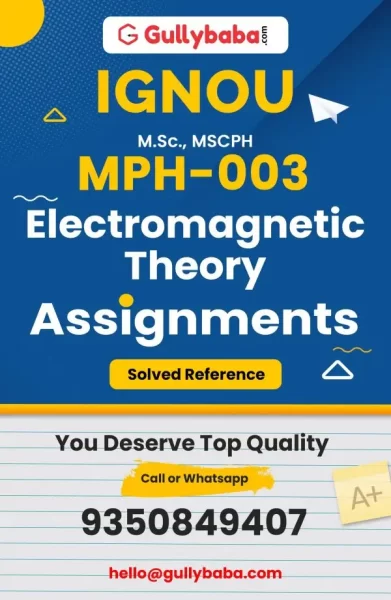PLEASE MATCH YOUR ASSIGNMENT QUESTIONS ACCORDING TO YOUR SESSION
IGNOU MPH-05 (January 2025 – December 2025) Assignment Questions
IGNOU MPH-05 (January 2024 – December 2024) Assignment Questions
PART A
1. a) What are the assumption made while deriving the ideal diode equation? Explain the effect of temperature on the breakdown voltage of the diode.
b) Define the External Quantum Efficiency (EQE) of an LED. Calculate its value for a semiconductor material with refractive index n2 = 3.6; assuming the refractive index of the air = 1.
c) Draw the symbols of following diodes:
i) Varactor diode, ii) Schottky diode, iii) p-i-n diode, iv) Tunnel diode
Explain the origin of negative resistance in Gunn diode with the help of appropriate E-k diagram. What are the applications of Gunn diode?
2. a) Explain with the help of appropriate diagram, how extremely high current gain can be obtained using the Darlington pair configuration of BJT.
b) Explain with the help of a circuit diagram and appropriate waveforms, how an SRC can be used for motor speed control. Suggest the modification in the circuit to turn it ON beyond 90° phase of the input ac cycle.
3. a) Discuss the effect of various circuit parameters governing the low frequency and high frequency responses of a transistor amplifier. Prove that the high frequency response of an amplifier decreases by 6 dB per octave unit.
b) In single ended input – single ended output configuration of a differential amplifier, the input voltage is 5 mV. If the collector resistors RC1= RC2= 51kΩ, emitter resistor RE= 47 kΩ and supply voltage is ±10V, calculate the differential gain and output voltage of the circuit.
4 a) Using frequency domain analysis obtain the expressions for the oscillation frequency and the required amplifier gain for a phase shift oscillator circuit.
b) Draw and explain the equivalent LCR resonant circuit of an oscillating crystal. Write the expression for its series resonant frequency and quality factor. What is the effect of the crystal thickness on its frequency?
c) Describe the five processes involved in the generation of microwaves in a vacuum tube device with the help of an example of a reflex klystron oscillator.
PART B
5. a) Draw the four possible negative feedback configurations of an op amp. Comment on the input and output impedances of these four circuits.
b) Design and draw the circuit using op amps to solve the following simultaneous equations:
2x + 3y = 12
– x + 3y = 3
6. a) Describe the factors giving rise to the output offset voltage of an op amp. Explain the method for measuring the output resistance of an op amp.
b) Explain the working of a Schmitt trigger using an op amp with the help of appropriate circuit diagram. Design a Schmitt trigger circuit with hysteresis of 20% of ±VSAT.
c) With the help of a circuit diagram explain the working of an active full wave rectifier. What are the advantages of using an op amp in rectifier and filter circuits? What is the limitation of using an op amp in a high pass filter circuit?
7. a) Explain the constant current limiting circuit implemented in a series voltage regulator. How is this circuit modified to achieve a fold-back configuration?
b) What are the advantages of switch mode dc-dc convertor over linear voltage regulator? Explain the working of buck convertor.
8. a) Explain the working of a PLL using a block diagram. Why is the capture range of a PLL always smaller than its lock range?
b) Explain the working of a tracking type ADC. Compare its performance with flash type ADC.
c) List the general purpose registers available in 8085 microprocessor. What is a data pointer? Describe the roles of accumulator and flag register in 8085.














